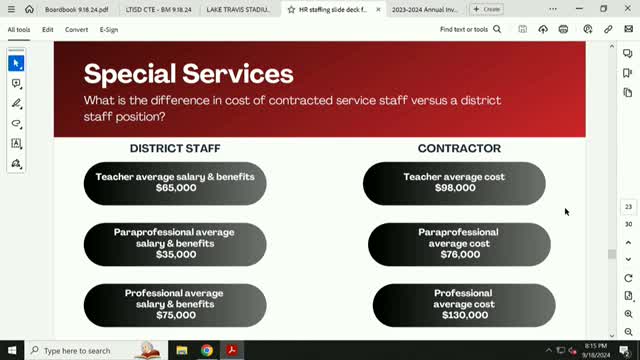School District Faces Staffing Crisis in Special Services
September 18, 2024 | LAKE TRAVIS ISD, School Districts, Texas
This article was created by AI summarizing key points discussed. AI makes mistakes, so for full details and context, please refer to the video of the full meeting. Please report any errors so we can fix them. Report an error »

During a recent government meeting, significant discussions centered around staffing challenges and budgetary concerns within the special services department. Board members expressed their commitment to improving the working conditions for teachers and paraprofessionals, particularly in light of high turnover rates and the reliance on contracted services.
One key point raised was the stark cost difference between hiring contractor paraprofessionals versus district staff, with the potential to employ two staff members for the price of one contractor. This financial strain has led to exceeding budget limits in special services, prompting a review of staffing needs and expenditures.
The board clarified that a recent audit by the Texas Association of School Boards (TASB) was not initiated to identify budget cuts but rather to assess the overall functioning of special services. This audit, ordered by the previous special services director, aimed to provide a comprehensive overview of the department's operations.
Concerns were also voiced regarding the well-being of teachers, particularly in special education, where staff reported feeling overworked. The district has implemented support systems, including an Employee Assistance Program (EAP) offering counseling sessions, to help staff manage stress. New employee onboarding emphasizes building relationships and encourages open communication about workload challenges.
The meeting highlighted the need for a thorough analysis of staff turnover, particularly among aides, and the financial implications of hiring and training new personnel. Board members underscored the importance of filling existing vacancies to ensure adequate support for students, especially in special education, where staffing ratios are critical for effective service delivery.
In conclusion, the board is actively seeking solutions to enhance retention and recruitment efforts, recognizing that addressing these staffing issues is essential for both the financial health of the district and the educational success of its students. The discussions reflect a collaborative approach among board members, administration, and community advocates to ensure that all students receive the support they need.
One key point raised was the stark cost difference between hiring contractor paraprofessionals versus district staff, with the potential to employ two staff members for the price of one contractor. This financial strain has led to exceeding budget limits in special services, prompting a review of staffing needs and expenditures.
The board clarified that a recent audit by the Texas Association of School Boards (TASB) was not initiated to identify budget cuts but rather to assess the overall functioning of special services. This audit, ordered by the previous special services director, aimed to provide a comprehensive overview of the department's operations.
Concerns were also voiced regarding the well-being of teachers, particularly in special education, where staff reported feeling overworked. The district has implemented support systems, including an Employee Assistance Program (EAP) offering counseling sessions, to help staff manage stress. New employee onboarding emphasizes building relationships and encourages open communication about workload challenges.
The meeting highlighted the need for a thorough analysis of staff turnover, particularly among aides, and the financial implications of hiring and training new personnel. Board members underscored the importance of filling existing vacancies to ensure adequate support for students, especially in special education, where staffing ratios are critical for effective service delivery.
In conclusion, the board is actively seeking solutions to enhance retention and recruitment efforts, recognizing that addressing these staffing issues is essential for both the financial health of the district and the educational success of its students. The discussions reflect a collaborative approach among board members, administration, and community advocates to ensure that all students receive the support they need.
View full meeting
This article is based on a recent meeting—watch the full video and explore the complete transcript for deeper insights into the discussion.
View full meeting
